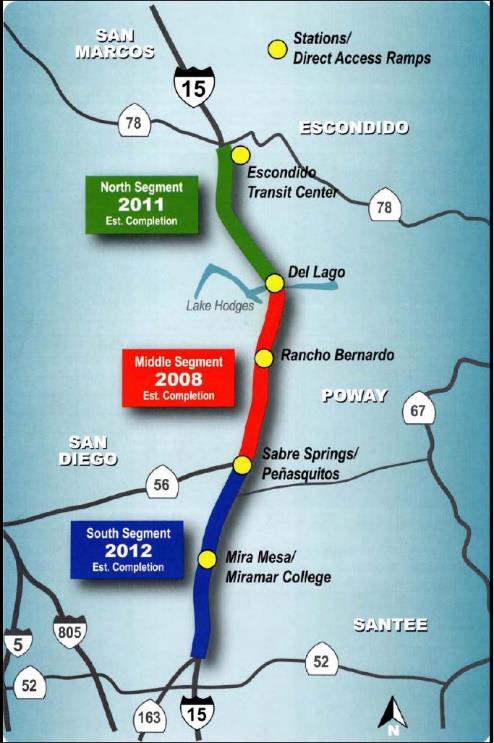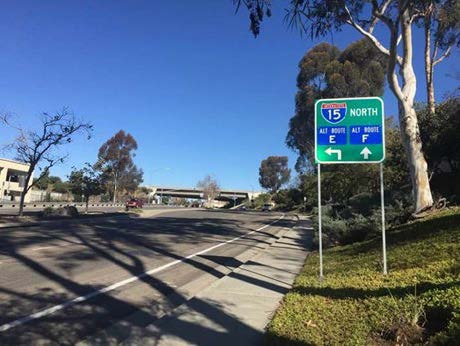This case study discusses "Demonstrating Integrated Corridor Management in San Diego." The project discussed in this case study was part of the USDOT's ICM Initiative and Demonstration Sites.
IN THIS CASE STUDY YOU WILL LEARN:
- Why a portion of San Diego’s I-15 corridor was well suited to be a demonstration site for Integrated Corridor Management (ICM).
- How ICM has benefited San Diego.
- How lessons learned from the San Diego demonstration are helping new deployers of ICM
Background

While public authorities once viewed roadway expansion (Figure 1) as a viable strategy to alleviate congestion, many network operators are now trying to better maximize throughput on existing roadways using a variety of strategies, including Integrated Corridor Management (ICM).1,2 ICM is a capacity maximization and congestion management strategy where transportation network operators account for and holistically manage “all elements in a corridor, including highways, arterial roads, and transit systems” to improve “throughput of travelers.” This is in contrast to more traditional network management where operators manage each mode individually.3 Ideally, by managing the system holistically, operators can reduce congestion, shift some nontransit travelers to transit, and better manage incidents. To do this, ICM systems typically utilize a variety of strategies such as improving traveler information and ramp metering.
| Problem | Traditionally, transportation modes are managed in a siloed manner which does not maximize roadway capacity |
| Goal | Develop a system that maximizes roadway capacity and allows transportation officials to holistically manage corridors. |
| Solution | Plan for, develop, and test an Integrated Corridor Management system in San Diego. This system successfully demonstrated a suite of technologies that allow for holistic management of a corridor and improve system throughput. |
Demonstrating ICM

In 2006, to test the viability of ICM systems, the US Department of Transportation (USDOT) started its ICM Demonstration Program. As part of a competitive bid process, USDOT selected San Diego and Dallas to develop ICM systems. This case study will focus on the San Diego implementation. Specifically, USDOT selected the San Diego Association of Governments (SANDAG) to implement an ICM system along a 21-mile stretch of the I-15 freeway roughly between Miramar and Escondido, California (Figure 2).4 This stretch of highway has several characteristics that made it a good candidate for ICM testing such as:
- A demonstrated need for congestion relief as this section had become increasingly congested due to suburban growth in Northern San Diego.
- Newly installed Express Lanes and Bus Rapid Transit (BRT) lanes which could be integrated into the ICM system.
- High-quality arterials next to the highway which could allow for traffic diversion from the freeway.
Building the System
As mentioned, ICM is an operational concept rather than a detailed suite of technologies or implementation practices. SANDAG first had to evaluate existing barriers to integration and its specific needs to figure out how to implement ICM.
| The Decision Support System (DSS) is a software tool that processes traffic data and recommends response plans. According to stakeholders, the DSS improved awareness of transportation conditions through better data integration and supported more robust response planning.4 |
A detailed needs assessment showed that SANDAG had a rich suite of traffic management technologies, such as ramp metering and dynamic message signs, already in place. Additionally, SANDAG had a variety of data such as weather data, 511 data, and incident data available which were useful for understanding traffic conditions. However, operationalizing these data and responding to traffic incidents in a coordinated manner was challenging. Therefore, SANDAG decided to create a Decision Support System (DSS) to ingest, synthesize, and operationalize its corridor data by recommending response plans. SANDAG also added route diversion signs and other technologies to enhance ICM efforts (Figure 3).
The DSS aggregates data from an array of sources such as traffic sensors and police incident reports and then utilizes advanced analytics tools to recommend, in near-real time, pre-approved traffic management strategies. These traffic management strategies include options such as diverting traffic along pre-determined routes, advising travelers of conditions, and coordinating ramp metering. This DSS better leveraged existing data to improve SANDAG’s decision making in the corridor.
Lessons Learned
ICM is Helpful for Managing Non-Recurrent Congestion

ICM delivered major benefits to SANDAG, but the benefits were somewhat different than expected. Although the ICM system helped smooth overall traffic operations along I-15, the ICM system did not experience daily use, and there was a low number of activations during the evaluation period.6 However, SANDAG found that the ICM system greatly aided its network managers’ ability to respond to non-recurrent congestion stemming from major crashes, sporting events, weather, etc.4
Transit Integration is an On-Going Process
While the ICM system was effective in supporting management of these irregular events, it did not fully deliver regular, expected modal shift benefits. Based on before and after surveys, few drivers reported switching modes as a result of the ICM system.6,4 Future ICM deployers may consider working more closely with transit agencies to better incorporate transit operations into ICM systems, since encouraging drivers to switch to transit is notoriously difficult.
Coordination Among Agencies is Crucial for Integration
Post-deployment modeling of the ICM system found:
|
One of the primary reasons for the success of the San Diego ICM system was coordination among stakeholders as implementing ICM requires multiple agencies to work together. By the end of the project, interagency cooperation and understanding, which would not have existed without the ICM program, was one of the key benefits of the project. However, it took time to build key partnerships and develop trust among stakeholders and in the DSS. Sites looking to deploy ICM should not underestimate the time and effort required to build these partnerships.
Many Agencies Have Learned from SANDAG and Are Implementing ICM in New Ways
Despite barriers to broader adoption of ICM, such as funding and institutional challenges, network operators have been able to build on the success of SANDAG’s ICM experience. Most directly, California Department of Transportation (CALTRANS) has leveraged its experiences with the SANDAG ICM program to start its Connected Corridors program which aims to implement ICM systems across the state of California.7 Iowa DOT is also undertaking ICM efforts in the greater Des Moines area, with deployment of different ICM technologies and policies beginning in 2021.8 Further afield, the Tennessee Department of Transportation has begun building an ICM-like system on I-24.
References
- Litman, Todd. “How 120 Years of Transportation Progress Affects Our Lives and Communities.” Victoria, Canada: Victoria Transport Policy Institute, October 7, 2020.
- Jeong, David. “Barriers to Right-of-Way Acquisition and Recommendations for Change.” St. Paul, Minnesota: Minnesota Department of Transportation, August 2016.
- Miller, Kevin T., Vassili Alexiadis, Alice Chu, Joel Ticatch, Aafiya Shah, Alyssa Phaneuf, and Tiffany Huang. Planning and Implementing Multimodal, Integrated Corridor Management:Guidebook. Washington, D.C.: Transportation Research Board, 2020. https://doi.org/10.17226/25906
- Hardesty, Dawn, and Greg Hatcher. “Integrated Corridor Management (ICM) Program: Major Achievements, Key Findings, and Outlook.” Washington, D.C.: Federal Highway Administration, July 2019.
- Alegre, Ellison. “Integrated Corridor Management.” Presented at the Joint ITE Workshop, San Juan Capistrano, CA, March 8, 2019.
- Alexiadis, Vassili, and Alice Chu. “Integrated Corridor Management: Analysis, Modeling, and Simulation for the I-15 Corridor in San Diego, California: Post-Deployment Assessment Report,” n.d., 95.
- Connected Corridors Program. “Connected Corridors Program.” Accessed February 23, 2021. https://connected-corridors.berkeley.edu/
- “Integrated Corridor Management (ICM) Strategies | Iowa DOT.” Accessed August 26, 2021. https://iowadot.gov/desmoinesicm/
- Reynolds, Jason. “TDOT Upgrades I-24 as High-Tech Highway.” The Murfreesboro Post. January 23, 2020. https://www.murfreesboropost.com/news/tdot-upgrades-i-24-as-high-tech-highway/article_f08ca0fc-3cdf-11ea-a32d-e7bbdaec448d.html

